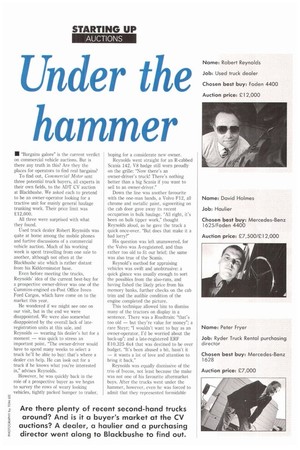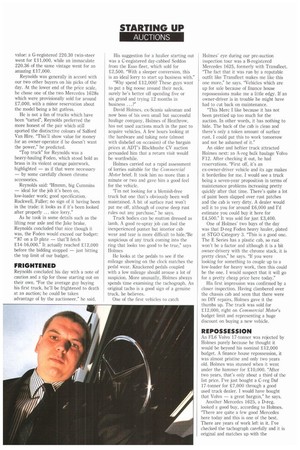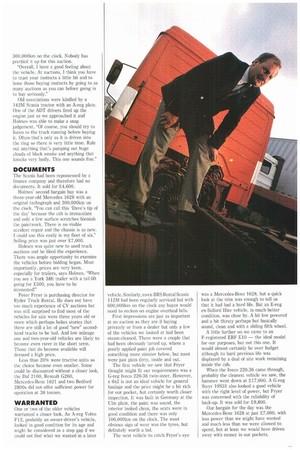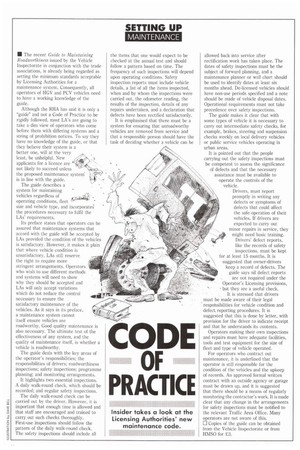Under the hammer
Page 30

Page 32

Page 33

Page 34

If you've noticed an error in this article please click here to report it so we can fix it.
Name: Robert Reynolds Job: Used truck dealer Chosen best buy: Foden 4400 Auction price: £12,000
• "Bargains galore" is the current verdict on commercial vehicle auctions. But is there any truth in this? Are they the places for operators to find real bargains?
To find out, Commercial Motor sent three potential truck buyers, all experts in their own fields, to the ADT CV auction at Blackbushe. We asked each to pretend to be an owner-operator looking for a tractive unit for mainly general haulage trunking work. Their price limit was £12,000.
All three were surprised with what they found.
Used truck dealer Robert Reynolds was quite at home among the mobile phones and furtive discussions of a commercial vehicle auction. Much of his working week is spent travelling from one sale to another, although not often at the Blackbushe site which is rather distant from his Kidderminster base.
Even before meeting the trucks, Reynolds' idea of the current best-buy for a prospective owner-driver was one of the Cummins-engined ex-Post Office Iveco Ford Cargos, which have come on to the market this year.
He wondered if we might see one on our visit, but in the end we were disappointed. We were also somewhat disappointed by the overall lack of lateregistration units at this sale, and Reynolds — wearing his dealer's hat for a moment — was quick to stress an important point. "The owner-driver would have to spend many weeks to select a truck he'll be able to buy: that's where a dealer can help. He can look out for a truck if he knows what you're interested in," advises Reynolds.
However, he was quickly back in the role of a prospective buyer as we began to survey the rows of weary looking vehicles, tightly packed bumper to trailer, hoping for a considerate new owner.
Reynolds went straight for an R-cabbed Scania 142, V8 badge still worn proudly on the grille: "Now there's an owner-driver's truck! There's nothing better than a big Scania if you want to sell to an owner-driver."
Down the line was another favourite with the one-man bands, a Volvo F12, all chrome and metallic paint, signwriting on the cab door gave away its recent occupation in bulk haulage. "All right, it's been on bulk tipper work," thought Reynolds aloud, as he gave the truck a quick once-over. "But does that make it a bad lorry?"
His question was left unanswered, for the Volvo was A-registered, and thus rather too old to fit our brief; the same was also true of the Scania.
Reynold's method for appraising vehicles was swift and unobtrusive: a quick glance was usually enough to sort the possibles from the also-rans, and having fished the likely price from his memory banks, further checks on the cab trim and the audible condition of the engine completed the picture.
This technique allowed him to dismiss many of the tractors on display in a sentence. There was a Roadtrain: "that's too old — but they're value for money"; a rare Steyr; "I wouldn't want to buy as an owner-operator, I'd be worried about the back-up"; and a late-registered ERF E10.325 6x4 that was destined to be over budget. "It's been abused a bit, hasn't it — it wants a lot of love and attention to bring it back."
Reynolds was equally dismissive of the trio of Ivecos, not least because the make was not one of his favourite aftermarket buys. After the trucks went under the hammer, however, even he was forced to admit that they represented formidable value: a G-registered 220.30 twin-steer went for £11,000, while an immaculate 220.36 of the same vintage went for an amazing £17,000.
Reynolds was generally in accord with our two other buyers on his picks of the day. At the lower end of the price scale, he chose one of. the two Mercedes 1628s which were provisionally sold for around £7,000, with a minor reservation about the model being a bit gutless.
He is not a fan of trucks which have been "tarted", Reynolds preferred the more honest of the pair which still sported the distinctive colours of Salford Van Hire. "This'll show value for money for an owner-operator if he doesn't want the power," he predicted.
"Top truck" for Reynolds was a heavy-hauling Foden, which stood bold as brass in its violent orange paintwork, highlighted — as if that were necessary — by some carefully chosen chrome accessories. Reynolds said: "Hmmm, big Cummins — ideal for the job it's been on, low-loader work; good specification, Rockwell, Fuller; no sign of it having been in the trade: it looks as if it's been looked after properly ... nice lorry."
As he took in some details such as the lifting rear axle and the Jake brake, Reynolds concluded that nice though it was, the Foden would exceed our budget: "87 on a D plate — that'll fetch £14-16,000." It actually reached £12,000 before the bidding stopped — just hitting the top limit of our budget.
FRIGHTENED
Reynolds concluded his day with a note of caution and a tip for those starting out on their own. "For the average guy buying his first truck, he'll be frightened to death at an auction; he could be taken advantage of by the auctioneer," he said. His suggestion for a haulier starting out was a C-registered day-cabbed Seddon from the Esso fleet, which sold for £2,500. "With a sleeper conversion, this is an ideal lorry to start up business with."
"Why spend £12,000? These guys want to put a big noose around their neck. surely he's better off spending five or six grand and trying 12 months in business ...?"
David Holmes, ex-Scania salesman and now boss of his own small but successful haulage company, Holmes of Heathrow, has not used auctions much in the past to acquire vehicles. A few hours looking at the hardware and taking note (almost with disbelief on occasion) of the bargain prices at ADrs Blackbushe CV auction persuaded him that a return visit would be worthwhile.
Holmes carried out a rapid assessment of lorries suitable for the Commercial Motor brief. It took him no more than a minute or two and gave him a good feel for the vehicle.
"I'm not looking for a blemish-free truck but one that's obviously been well maintained. A bit of surface rust won't put me off, although of course deep rust rules out any purchase," he says.
Truck bodies can be mutton dressed as lamb. A good re-spray job can fool the inexperienced punter but interior cab wear and tear is more difficult to hide."Be suspicious of any truck coming into the ring that looks too good to be true," says Holmes He looks at the pedals to see if the mileage showing on the clock matches the pedal wear. Knackered pedals coupled with a low mileage should arouse a lot of suspicion. More unusually, Holmes always spends time examining the tachograph. An original tacho is a good sign of a genuine truck, he believes.
One of the first vehicles to catch Holmes' eye during our pre-auction inspection tour was a B-registered Mercedes 1625, formerly with Transfleet. "The fact that it was run by a reputable outfit like Transfleet makes me like this one more," he says. "Vehicles which are up for sale because of finance house repossessions make me a little edgy. If an owner-driver is in trouble he might have had to cut back on maintenance.
"This Merc I like because it has not been prettied up too much for the auction. In other words, it has nothing to hide. The back of the cab is clean and there's only a token amount of surface rust. I could put this to work tomorrow and not be ashamed of it."
An older and heftier truck attracted Holmes next: an A-reg bulk haulage Volvo F12. After checking it out, he had reservations. "First off, it's an ex-owner-driver vehicle and its age makes it borderline for me. I would see a truck being a seven-year proposition in terms of maintenance problems increasing pretty quickly after that time. There's quite a lot of paint been slapped over rust patches and the cab is very dirty. A dealer would sell it to you for around £6,000 and I'd estimate you could buy it here for £4,500." It was sold for just £3,400.
One of Holmes' two buys of the day was that D-reg Foden heavy hauler, plated at STGO Category 3. "This is a good one. The E Series has a plastic cab, so rust won't be a factor and although it is a bit owner-drivery with the chrome stack, it is pretty clean," he says. "If you were looking for something to couple up to a low-loader for heavy work, then this could be the one. I would suspect that it will go for a pretty cheap price here today."
His first impression was confirmed by a closer inspection. Having clambered over the chassis cab and seen that there were no DIY repairs, Holmes gave it the thumbs up. The truck was sold for £12,000, right on Commercial Motor's budget limit and representing a huge discount on buying a new vehicle.
REPOSSESSION
An FI.6 Volvo 17-tonner was rejected by Holmes purely because he thought it would be beyond his nominal £12,000 budget. A finance house repossession, it was almost pristine and only two years old. Holmes was stunned when it went under the hammer for £10,000. "After two years, that's only about a third of the list price. I've just bought a C-reg Daf 17-tonner for £7,000 through a good used truck dealer. I would have bought that Volvo — a great bargain," he says.
Another Mercedes 1625, a D-reg, looked a good buy, according to Holmes. "There are quite a few good Mercedes here today and this is one of the best. There are years of work left in it. I've checked the tachograph carefully and it is original and matches up with the 300,000km on the clock. Nobody has prettied it up for this auction.
-Overall, I have a good feeling about the vehicle. At auctions, I think you have to trust your instincts a little bit and to hone those buying instincts by going to as many auctions as you can before going in to buy seriously."
Old associations were kindled by a 142M Scania tractor with an A-reg plate. One of the ADT drivers fired up the engine just as we approached it and Holmes was able to make a snap judgement. "Of course, you should try to listen to the truck running before buying it. Often that's only as it is driven into the ring so there is very little time. Rule out anything that's pumping out huge clouds of black smoke and anything that knocks very badly. This one sounds fine."
DOCUMENTS
The Scania had been repossessed by a finance company and therefore had no documents. It sold for £4,600.
Holmes' second bargain buy was a three-year-old Mercedes 1628 with an original tachograph and 300,000km on the clock. "You can call this `Dave's tip of the day' because the cab is immaculate and only a few surface scratches blemish the paintwork. There is no visible accident repair and the chassis is as new. I could use this easily in my fleet of six." Selling price was just over £7,000.
Holmes was quite new to used truck auctions and he liked the experience. There was ample opportunity to examine the vehicles before bidding began. Most importantly, prices are very keen, especially for trailers, says Holmes. "When you see a York 38ft trailer with a tail-lift going for £500, you have to be interested!"
Peter Fryer is purchasing director for Ryder Truck Rental. He does not have too much experience of CV auctions but was still surprised to find most of the vehicles for sale were three years old or more which perhaps belies stories that there are still a lot of good "new" secondhand trucks to be had. And low mileage one and two-year-old vehicles are likely to become even rarer in the short term. Those that do become available will demand a high price.
Less than 20% were tractive units so the choice became even smaller. Some could be discounted without a closer look, the Hai 2100, Renault G260, Mercedes-Benz 1621 and two Bedford 2800s did not offer sufficient power for operation at 38 tonnes.
WARRANTED
One or two of the older vehicles warranted a closer look. An A-reg Volvo F12, probably an owner-driver's vehicle, looked in good condition for its age and might be considered as a stop gap if we could not find what we wanted in a later vehicle. Similarly, an ex-BRS Rental Scania 112M had been regularly serviced but with 600,000km on the clock any buyer would need to reckon on engine overhaul bills.
First impressions are just as important at an auction as they are if buying privately or from a dealer but only a few of the vehicles we looked at had been steam-cleaned, There were a couple that had been obviously tarted up, where a poorly applied paint job covered something more sinister below, but most were just plain dirty, inside and out.
The first vehicle we saw that Fryer thought might fit our requirements was a G-reg Iveco 220-36 twin-steer. However, a 6x2 is not an ideal vehicle for general haulage and the price might be a bit rich for our pocket, but certainly worth closer inspection. It was built in Germany at the Ulm plant, the paint was sound, the interior looked clean, the seats were in good condition and there was only 106,000km on the clock. The most obvious sign of wear was the tyres, but definitely worth a bid.
The next vehicle to catch Fryer's eye was a Mercedes-Benz 1628, but a quick look at the trim was enough to tell us that it had had a hard life. But an E-reg ex-Salford Hire vehicle, in much better condition, was close by. A bit low powered and a bit thirsty perhaps but basically sound, clean and with a sliding fifth wheel.
A little further on we came to an F-registered ERF El0 — the ideal model for our purposes, but not this one. It would almost certainly be over budget although its hard previous life was displayed by a deal of site work remaining inside the cab.
When the Iveco 220.36 came through, probably the cleanest vehicle we saw, the hammer went down at £17,000. A G-reg Steyr 19S31 also looked a good vehicle with the right level of power, but Fryer was concerned with the reliability of back-up. It was sold for £9,800.
Our bargain for the day was the Mercedes-Benz 1628 at just £7,000, with less power than we might have wanted and much less than we were allowed to spend, but at least we would have driven away with money in our pockets.
• The recent Guide to Maintaining Roadworthiness issued by the Vehicle Inspectorate in conjunction with the trade associations, is already being regarded as setting the minimum standards acceptable by Licensing Authorities for a maintenance system. Consequently, all operators of HGV and PCV vehicles need to have a working knowledge of the guide.
Although the RHA has said it is only a "guide" and not a Code of Practice to be rigidly followed, most LA's are going to take a dim view of operators who come before them with differing systems and a string of prohibition notices. To say they have no knowledge of the guide, or that they believe their system is a better one, will at the very least, be unhelpful. New applicants for a licence are not likely to succeed unless the proposed maintenance system' is in line with the guide.
The guide describes a system for maintaining
vehicles regardless of ov„.4141, operating conditions, fleet -size and vehicle type, and incorporated the procedures necessary to fulfil the LAs' requirements.
Its preface states that operators can be assured that maintenance systems that accord with the guide will be accepted by LAs provided the condition of the vehicles is satisfactory. However, it makes it plain that where vehicle condition is unsatisfactory, LAs still reserve the right to require more stringent arrangements. Operators who wish to use different methods and systems will need to show why they should be accepted and LAs will only accept variations which do not reduce the control necessary to ensure the satisfactory maintenance of the vehicles. As it says in its preface, a maintenance system cannot itself ensure vehicles are roadworthy. Good quality maintenance is also necessary. The ultimate test of the effectiveness of any system, and the quality of maintenance itself, is whether a vehicle is roadworthy.
The guide deals with the key areas of the operator's responsibilities; the responsibilities of drivers; roadworthiness inspections; safety inspections; programme planning; and monitoring arrangements.
It highlights two essential inspections. A daily walk-round check, which should be recorded; and regular safety inspections.
The daily walk-round check can be carried out by the driver. However, it is important that enough time is allowed and that staff are encouraged and trained to carry out such checks thoroughly. First-use inspections should follow the pattern of the daily walk-round check. The safety inspections should include all the items that one would expect to be checked at the annual test and should follow a pattern based on time. The frequency of such inspections will depend upon operating conditions. Safety inspection reports must include vehicle details, a list of all the items inspected, when and by whom the inspections were carried out, the odometer reading, the results of the inspection, details of any repairs undertaken, and a declaration that defects have been rectified satisfactorily.
It is emphasised that there must be a system for ensuring that unroadworthy vehicles are removed from service and that a responsible person should have the task of deciding whether a vehicle can be allowed back into service after rectification work has taken place. The dates of safety inspections must be the subject of forward planning, and a maintenance planner or wall chart should be used to identify dates at least six months ahead. De-licensed vehicles should have non-use periods specified and a note should be made of vehicle disposal dates. Operational requirements must not take precedence over safety inspections.
The guide makes it clear that with some types of vehicle it is necessary to carry out intermediate safety checks, for example, brakes, steering and suspension checks weekly on local delivery vehicles or public service vehicles operating in urban areas.
It is pointed out that the people carrying out the safety inspections must be competent to assess the significance of defects and that the necessary assistance must be available to operate the controls of the vehicle.
Drivers, must report promptly in writing any defects or symptoms of defects that could affect the safe operation of their vehicles. If drivers are expected to carry out minor repairs in service, they might need basic training.
Drivers' defect reports, like the records of safety inspections, must be kept for at least 15 months. It is \ suggested that owner-drivers keep a record of defects. The guide says nil defect reports are not required under the Operator's Licensing provisions, but they are a useful check.
It is stressed that drivers s must be made aware of their legal .respohsibilities for vehicle condition and defect, reporting procedures. It is suggested that this is done by letter, with provision for the driver to indicate receipt and that he understands its contents.
Operators making their own inspections and repairs must have adequate facilities, tools and test equipment for the size of fleet and type of vehicle operated.
For operators who contract out maintenance, it is underlined that the operator is still responsible for the condition of the vehicles and the upkeep of records. An approved formal written contract with an outside agency or garage must be drawn up, and it is suggested that there should be a means of regularly monitoring the contractor's work. It is made clear that any change in the arrangements for safety inspections must be notified to the relevant Traffic Area Office. Many operators are not aware of this.
El Copies of the guide can be obtained from the Vehicle Inspectorate or from HMSO for O.












































































